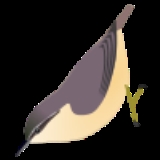
Corsican Nuthatch
Encyclopedia
The Corsican Nuthatch, Sitta whiteheadi, is a small passerine
bird
which is endemic
to Corsica
, where it is the only nuthatch.
The Corsican Nuthatch is a resident bird of the mountain forests of Corsica, and is closely associated with Corsican Pine preferably with some very old trees aged 300 years or more for nesting.
It feeds on insects and seeds, especially those of the Corsican Pine, which are stored in food caches.
It has the ability, like other nuthatches, to climb down trees, unlike species such as woodpecker
s which can only go upwards, and will also flycatch.
The Corsican Nuthatch is 12cm long, smaller than the Eurasian Nuthatch
, and has the typical nuthatch big head, short tail and powerful bill and feet. It is blue-grey above, and buff below. The male has a black crown and eyestripe separated by a white supercilium. The female has a grey crown and eyestripe. Young birds are duller versions of the adults.
This territorial species nests in holes in old Corsican Pines, which are usually self-excavated. Five to eight eggs are laid, white speckled with red.
The Corsican Nuthatch has a pu-pu-pu call and a trilled hididididididi song.
The population is about 2,000 pairs; the main threats are fire, which destroys the habitat, and predation by Great Spotted Woodpecker
s. Since 2010 this bird is considered as a vulnerable species.
The binomial of this bird commemorates the British collector John Whitehead
(1860-1899), who collected the type specimen in June 1883.
Passerine
A passerine is a bird of the order Passeriformes, which includes more than half of all bird species. Sometimes known as perching birds or, less accurately, as songbirds, the passerines form one of the most diverse terrestrial vertebrate orders: with over 5,000 identified species, it has roughly...
bird
Bird
Birds are feathered, winged, bipedal, endothermic , egg-laying, vertebrate animals. Around 10,000 living species and 188 families makes them the most speciose class of tetrapod vertebrates. They inhabit ecosystems across the globe, from the Arctic to the Antarctic. Extant birds range in size from...
which is endemic
Endemic (ecology)
Endemism is the ecological state of being unique to a defined geographic location, such as an island, nation or other defined zone, or habitat type; organisms that are indigenous to a place are not endemic to it if they are also found elsewhere. For example, all species of lemur are endemic to the...
to Corsica
Corsica
Corsica is an island in the Mediterranean Sea. It is located west of Italy, southeast of the French mainland, and north of the island of Sardinia....
, where it is the only nuthatch.
The Corsican Nuthatch is a resident bird of the mountain forests of Corsica, and is closely associated with Corsican Pine preferably with some very old trees aged 300 years or more for nesting.
It feeds on insects and seeds, especially those of the Corsican Pine, which are stored in food caches.
It has the ability, like other nuthatches, to climb down trees, unlike species such as woodpecker
Woodpecker
Woodpeckers are near passerine birds of the order Piciformes. They are one subfamily in the family Picidae, which also includes the piculets and wrynecks. They are found worldwide and include about 180 species....
s which can only go upwards, and will also flycatch.
The Corsican Nuthatch is 12cm long, smaller than the Eurasian Nuthatch
Eurasian Nuthatch
The Eurasian Nuthatch, Sitta europaea, is a small passerine found throughout temperate Europe and Asia, although not in Ireland. It belongs to the nuthatch family Sittidae....
, and has the typical nuthatch big head, short tail and powerful bill and feet. It is blue-grey above, and buff below. The male has a black crown and eyestripe separated by a white supercilium. The female has a grey crown and eyestripe. Young birds are duller versions of the adults.
This territorial species nests in holes in old Corsican Pines, which are usually self-excavated. Five to eight eggs are laid, white speckled with red.
The Corsican Nuthatch has a pu-pu-pu call and a trilled hididididididi song.
The population is about 2,000 pairs; the main threats are fire, which destroys the habitat, and predation by Great Spotted Woodpecker
Great Spotted Woodpecker
The Great Spotted Woodpecker , Dendrocopos major, is a bird species of the woodpecker family . It is distributed throughout Europe and northern Asia, and usually resident year-round except in the colder parts of its range...
s. Since 2010 this bird is considered as a vulnerable species.
The binomial of this bird commemorates the British collector John Whitehead
John Whitehead (explorer)
John Whitehead was an English explorer, naturalist and professional collector of bird specimens.Whitehead travelled in Malacca, North Borneo, Java, and Palawan between 1885 and 1888, where he collected a number of zoological specimens new to science, including Whitehead's Broadbill , writing up...
(1860-1899), who collected the type specimen in June 1883.

